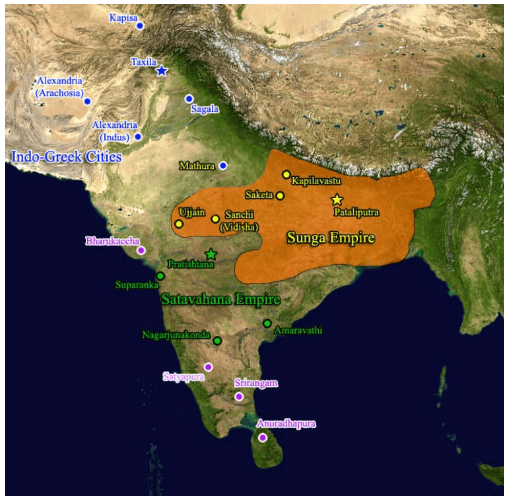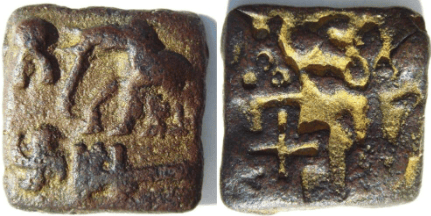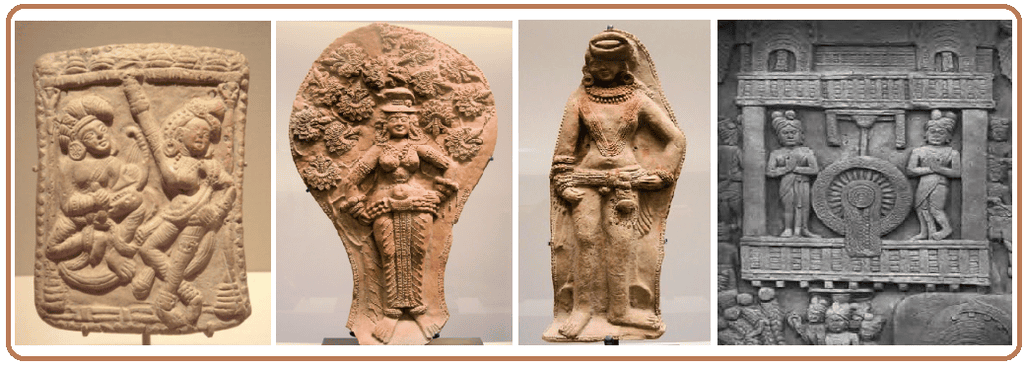Sunga Dynasty | History Optional for UPSC PDF Download
The Decline of the Mauryan Empire After Asoka
After the death of Asoka, the Mauryan Empire began to weaken. His successors were unable to maintain control over the vast territory that Asoka had ruled. Here’s a closer look at what happened:- The provinces of the empire started to declare their independence, breaking away from Mauryan control.
- Northern India, particularly the northwest region, slipped out of Mauryan control. This area faced a series of foreign invasions, further destabilizing the region.
- Kalinga, which had been part of the Mauryan Empire, declared its independence. This was a significant loss for the Mauryans.
- In the south, the Satavahanas established their own independent rule, further eroding the Mauryan territory.
- As a result of these developments, Mauryan rule became confined to the Gangetic Valley. Eventually, the Mauryan Empire was replaced by the Sunga dynasty, which took over as the new ruling power in the region.
Sunga Empire (187 to 78 BCE)
 Pushyamitra Sunga (187–151 BCE)
Pushyamitra Sunga (187–151 BCE)
- Pushyamitra Sunga, the founder of the Sunga dynasty, was originally the commander-in-chief under the Maurya Empire.
- According to the Harshacharita, Pushyamitra assassinated the Maurya king Brihadratha during an inspection of the troops, marking the end of Maurya rule in 187 BCE and his usurpation of the throne.
- Although the capital was initially Pataliputra, later emperors like Bhagabhadra also held court at Besnagar (modern Vidisha).
Origin
- The Puranas describe Pushyamitra as a member of the Shunga family.
- References to Shunga teachers in Vedic texts, such as the mention of a teacher named Shaungiputra in the Brihadaranyaka Upanishad, support this.
- Panini links the Shungas to the Brahmana Bharadvaja gotra.
- Kalidasa’s Malavikagnimitra describes Agnimitra, Pushyamitra's son, as belonging to the Baimbika kula (family) and Kashyapa gotra.
- These sources collectively indicate that the Shungas were Brahmanas.
- The term “Sunga” in Sanskrit means the fig tree, suggesting that the dynasty derived its name from this tree, similar to other Indian dynasties like Kadamba and Pallava.
Challenges and Conflicts
- One of the primary challenges for the Sunga rule was defending north India against invasions by the Bactrian Greeks from the northwest.
- The Greeks advanced as far as Pataliputra and temporarily occupied it, but Pushyamitra eventually regained the lost territory.
- Pushyamitra also campaigned against Kharavela of Kalinga, who invaded north India.
Extent of Empire
- Pushyamitra’s empire covered only a portion of the former Maurya Empire.
- It included Pataliputra (the capital), Ayodhya, and Vidisha.
- According to the Divyavadana and Taranatha’s account, it also encompassed Jalandhara and Shakala in Punjab.
- Pushyamitra appointed viceroys in some parts of his empire; for instance, Agnimitra served as viceroy at Vidisha in Kalidasa’s Malavikagnimitra.
Conflicts and Sacrifices
- Malavikagnimitra narrates the conflict between Pushyamitra and Yajnasena, the king of Vidarbha, highlighting the Shungas' victory.
- The Shungas also encountered conflicts with the Bactrian Greeks.
- Patanjali, a 2nd-century BCE grammarian, refers to the yavanas (Greeks) reaching places like Saketa (Ayodhya) and Madhyamika (near Chittor in Rajasthan).
- During this period, the term yavanas broadly referred to foreigners from the West, including the Greeks.
- Patanjali also mentions sacrifices performed for Pushyamitra.
- The Malavikagnimitra recounts a military encounter between prince Vasumitra and a Yavana army by the Sindhu River.
- This conflict occurred during Pushyamitra’s ashvamedha sacrifice when the Yavanas challenged the horse accompanied by the young prince and his soldiers.
- The Yavanas were defeated, and the horse was brought back safely.
- The Ayodhya stone inscription of king Dhana credits Pushyamitra with performing two ashvamedha sacrifices.
- The Divyavadana portrays Pushyamitra as cruel and hostile towards Buddhism.
Religious Policy
- Pushyamitra was a dedicated follower of Brahmanism and performed two ashvamedha sacrifices.
- Buddhist sources depict him as a persecutor of Buddhism, but there is evidence that he patronized Buddhist art.
- During his reign, the Buddhist monuments at Bharhut and Sanchi were renovated and improved.
Prosecution of Buddhists?
- Some historians believe that Pushyamitra persecuted Buddhists and contributed to the resurgence of Brahmanism, pushing Buddhism to regions like Kashmir, Gandhara, and Bactria.
- The earliest reference to Pushyamitra’s persecution of Buddhists comes from the Sarvastivadin Buddhist text Divyavadana and its part Ashokavadana in the 2nd Century CE.
- Tibetan Buddhist historian Taranatha also mentions this persecution.
- Pushyamitra may have withdrawn royal support from Buddhist institutions, shifting patronage to Brahmanism.
- This shift may have led Buddhists to side with Pushyamitra’s enemies, the Indo-Greeks.
- Historians cite several reasons for Pushyamitra’s prosecution of Buddhists:
- Damage to Buddhist establishments at Takshashila during the Sunga period.
- Destruction of the Sanchi stupa by Pushyamitra, later restored by his successor Agnimitra.
- Construction of the Bharhut Stupa gateway by Pushyamitra’s successors, not during his time.
- Destruction of Ghositarama monastery at Kaushambi in the 2nd century CE, attributed to Pushyamitra.
- Destruction of Deokothar Stupas during the same period, suggesting Sunga involvement.
- Some historians doubt the narrative of Pushyamitra’s persecution of Buddhists due to:
- Absurdity of Taranatha’s account.
- Archaeological evidence questioning claims of persecution.
- Belief that the Ashokavadana legend reflects the declining influence of Buddhism in the Sunga court.
- Similarity of cruelty attributed to Ashoka against the Ajivikas in the same text.
- Support of Buddhism by the Sungas at some point, as suggested by an epigraph on the Bharhut gateway.
- Existence of Buddhism in Bengal during the Sunga period, inferred from a terracotta tablet found at Tamralipti.
- Buddhism thrived under the Kushanas and Shakas after the Sunga Dynasty, indicating that it did not suffer significant setbacks during the Sunga rule.
Agnimitra (149–141 BCE)
- After Pushyamitra's death, his son Agnimitra took over as the ruler.
- Agnimitra is the hero of Kalidasa's play Malavikagnimitra. In this play, Kalidasa describes Agnimitra as belonging to the Baimbika family(Baimbika-kula), while the Puranas refer to him as a Sunga.
- The Malavikagnimitra also tells us about a war between the Sungas and the neighboring Vidarbha kingdom during Agnimitra's rule.
- Before the Sungas came to power, Vidarbha, under Yajnasena, had gained independence from the Mauryan Empire. However, Yajnasena was defeated by the Sungas and had to accept their suzerainty.
Vasumitra:
- According to Kalidasa in the Malavikagnimitram, Vasumitra played a significant role by safeguarding the sacrificial horse released by his grandfather Pushyamitra. He achieved a notable victory over the armies of the “Yavana” (Indo-Greeks) along the banks of the Sindhu River.
Devabhuti (83–73 BCE):
- According to historical records, ten Shunga kings are believed to have ruled for a total of 112 years. The Puranas indicate that Devabhuti was the last ruler of this line.
- The Harshacharita describes how Devabhuti fell victim to a conspiracy orchestrated by his Brahmana minister Vasudeva, who subsequently established the Kanva dynasty.
- It is likely that remnants of Shunga rule persisted in central India for a period until the rise of the Satavahanas.
- The Shunga dynasty played a crucial role in defending the Gangetic valley from foreign invasions. Culturally, they revived Brahmanism and horse sacrifice, while also promoting the growth of Vaishnavism and the Sanskrit language.
- In essence, the Sunga rule can be seen as a brilliant precursor to the golden age of the Guptas.

Cultural Contributions of the Sungas
- The Sunga period was a time of significant cultural development in India, particularly in the fields of art, education, philosophy, and learning. This era is marked by the composition of important texts such as Patanjali's Yoga Sutras and Mahabhasya. These works reflect the rich intellectual and spiritual life of the time.
- One notable literary work from a later period is the Malavikagnimitra, written by the famous poet Kalidasa during the Gupta period. This play tells the romantic story of Malavika and King Agnimitra, set against a backdrop of court intrigue, and provides insight into the cultural and social life of the time.
- The Sunga period also witnessed the rise of the Mathura school of art, which is considered the indigenous counterpart to the Hellenistic Gandhara school of art. This development signifies the flourishing of artistic expression and local craftsmanship during this time.
Sunga Art
- During the Sunga period, art thrived with the creation of standing sculptures of Yakshas and Yakshis, particularly found in regions like Gwalior and Mathura. These sculptures reflect the vibrant artistic tradition of the time.
- Buddhist activity continued to endure in central India, as evidenced by architectural expansions at the stupas of Sanchi and Barhut. These expansions were initially started under Emperor Ashoka but saw significant development during the Sunga period.
- The Sungas played a crucial role in the expansion of the Bharut and Sanchi Stupas. At Sanchi, various edifices were raised, including the enlargement of the Ashokan stupa. This enlargement involved facing the stupa with locally available dark purple-grey sandstone and adding decorative elements such as balustrades, staircases, and a harmika on top.
- Later Sunga emperors exhibited a favorable attitude towards Buddhism and contributed to the construction of the stupa at Bharhut, further highlighting the religious and cultural importance of this period.

The Besnagar pillar inscription of Heliodorus:
- An intriguing inscription from the Shunga period is found on a pillar at Besnagar, the location of ancient Vidisha. This inscription, written in Prakrit using the Brahmi script, reveals significant historical details.
- The inscription declares the pillar as a garuda-pillar dedicated to Vasudeva. In this context,garuda refers to the bird that serves as the vehicle of the god Vishnu.
- Furthermore, the Besnagar pillar inscription suggests that the Shunga rulers upheld the Maurya tradition of welcoming ambassadors from Greek courts.
- Heliodorus, the Greek ambassador, identifies himself as a Bhagavata, a devotee of the god Vasudeva Krishna. He erected this pillar to honor this deity.
- Heliodorus describes himself as a Parambhagavata, hailing from Taxila, and the son of Divya. He was sent as an ambassador by the Greek king Antialcidas to the Indian king Kasiputra, believed to be a Sunga ruler.
- The remnants of a structure near the pillar are thought to be the remains of an ancient temple, where the Greek ambassador commemorated his devotion through the inscribed record.
Art of Vidisha:
Vidisha, during the Sunga rule, was a significant center for trade, art, and religion, and it served as a capital. The art of Vidisha flourished between 200 BC and 100 BC, particularly during the Shunga period. Vidisha art can be classified into three main categories:
- Free-standing stone pillars
- Stone capitals without shafts
- Sculptural art
Free-standing Stone Pillar in Besnagar
- A stone pillar was erected by the Greek ambassador Heliodorus, known as the "Garuda Dhwaj."
- The pillar stands at approximately 20 feet tall and is unpolished.
- Both the shaft and capital are present, with the shaft divided into four equal sections. Each section has a different shape.
- The top section is circular, while the three lower sections have eight, sixteen, and thirty-two sides, respectively.
- There is a garland ornamentation between the second and third sections.
- The capital consists of two parts:
- Lower capital: A bell-shaped or inverted lotus capital.
- Upper capital: Originally featuring a Garuda emblem, though it is currently represented by leaves.
|
367 videos|995 docs
|
FAQs on Sunga Dynasty - History Optional for UPSC
| 1. What were the main reasons for the decline of the Mauryan Empire after Asoka? |  |
| 2. Who was Agnimitra and what was his significance in the Sunga Empire? |  |
| 3. What were the cultural contributions of the Sunga Dynasty? |  |
| 4. What is the Besnagar pillar inscription of Heliodorus and its historical significance? |  |
| 5. How did Devabhuti's reign impact the Sunga Empire? |  |
















